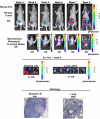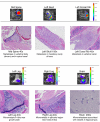Bioluminescent human breast cancer cell lines that permit rapid and sensitive in vivo detection of mammary tumors and multiple metastases in immune deficient mice
- PMID: 15987449
- PMCID: PMC1175057
- DOI: 10.1186/bcr1026
Bioluminescent human breast cancer cell lines that permit rapid and sensitive in vivo detection of mammary tumors and multiple metastases in immune deficient mice
Abstract
Introduction: Our goal was to generate xenograft mouse models of human breast cancer based on luciferase-expressing MDA-MB-231 tumor cells that would provide rapid mammary tumor growth; produce metastasis to clinically relevant tissues such as lymph nodes, lung, and bone; and permit sensitive in vivo detection of both primary and secondary tumor sites by bioluminescent imaging.
Method: Two clonal cell sublines of human MDA-MB-231 cells that stably expressed firefly luciferase were isolated following transfection of the parental cells with luciferase cDNA. Each subline was passaged once or twice in vivo to enhance primary tumor growth and to increase metastasis. The resulting luciferase-expressing D3H1 and D3H2LN cells were analyzed for long-term bioluminescent stability, primary tumor growth, and distal metastasis to lymph nodes, lungs, bone and soft tissues by bioluminescent imaging. Cells were injected into the mammary fat pad of nude and nude-beige mice or were delivered systemically via intracardiac injection. Metastasis was also evaluated by ex vivo imaging and histologic analysis postmortem.
Results: The D3H1 and D3H2LN cell lines exhibited long-term stable luciferase expression for up to 4-6 months of accumulative tumor growth time in vivo. Bioluminescent imaging quantified primary mammary fat pad tumor development and detected early spontaneous lymph node metastasis in vivo. Increased frequency of spontaneous lymph node metastasis was observed with D3H2LN tumors as compared with D3H1 tumors. With postmortem ex vivo imaging, we detected additional lung micrometastasis in mice with D3H2LN mammary tumors. Subsequent histologic evaluation of tissue sections from lymph nodes and lung lobes confirmed spontaneous tumor metastasis at these sites. Following intracardiac injection of the MDA-MB-231-luc tumor cells, early metastasis to skeletal tissues, lymph nodes, brain and various visceral organs was detected. Weekly in vivo imaging data permitted longitudinal analysis of metastasis at multiple sites simultaneously. Ex vivo imaging data from sampled tissues verified both skeletal and multiple soft tissue tumor metastasis.
Conclusion: This study characterized two new bioluminescent MDA-MB-231-luc human breast carcinoma cell lines with enhanced tumor growth and widespread metastasis in mice. Their application to current xenograft models of breast cancer offers rapid and highly sensitive detection options for preclinical assessment of anticancer therapies in vivo.
Figures





Similar articles
-
Suppression of distant pulmonary metastasis of MDA-MB 435 human breast carcinoma established in mammary fat pads of nude mice by retroviral-mediated TIMP-2 gene transfer.J Gene Med. 2005 Feb;7(2):145-57. doi: 10.1002/jgm.645. J Gene Med. 2005. PMID: 15546163
-
Imaging of bioluminescent LNCaP-luc-M6 tumors: a new animal model for the study of metastatic human prostate cancer.Prostate. 2004 May 15;59(3):292-303. doi: 10.1002/pros.20003. Prostate. 2004. PMID: 15042605
-
[Establishment of a bioluminescent MDA-MB-231 cell line for in vivo imaging of human triple-negative breast cancer xenograft].Nan Fang Yi Ke Da Xue Xue Bao. 2011 Nov;31(11):1812-8. Nan Fang Yi Ke Da Xue Xue Bao. 2011. PMID: 22126756 Chinese.
-
On the development of models in mice of advanced visceral metastatic disease for anti-cancer drug testing.Cancer Metastasis Rev. 2007 Dec;26(3-4):737-47. doi: 10.1007/s10555-007-9087-6. Cancer Metastasis Rev. 2007. PMID: 17846863 Review.
-
Metastases of human tumors in experimental animals.Anticancer Res. 1987 Sep-Oct;7(5B):997-1003. Anticancer Res. 1987. PMID: 3324940 Review.
Cited by
-
Application of ex vivo micro-computed tomography for assessment of in vivo fluorescence and plain radiographic imaging for monitoring bone metastases and osteolytic lesions.J Bone Miner Metab. 2012 May;30(3):373-80. doi: 10.1007/s00774-011-0335-z. Epub 2011 Dec 2. J Bone Miner Metab. 2012. PMID: 22130787
-
Detection of disseminated tumor cells in the bone marrow of breast cancer patients using multiplex gene expression measurements identifies new therapeutic targets in patients at high risk for the development of metastatic disease.Breast Cancer Res Treat. 2013 Jan;137(1):45-56. doi: 10.1007/s10549-012-2279-y. Epub 2012 Nov 6. Breast Cancer Res Treat. 2013. PMID: 23129172 Free PMC article.
-
Vitamin D enhances the efficacy of photodynamic therapy in a murine model of breast cancer.Cancer Med. 2015 May;4(5):633-42. doi: 10.1002/cam4.361. Epub 2015 Feb 25. Cancer Med. 2015. PMID: 25712788 Free PMC article.
-
Deciphering the molecular basis of breast cancer metastasis with mouse models.Rev Endocr Metab Disord. 2007 Sep;8(3):199-213. doi: 10.1007/s11154-007-9041-5. Rev Endocr Metab Disord. 2007. PMID: 17657606 Review.
-
Significance of PELP1/HDAC2/miR-200 regulatory network in EMT and metastasis of breast cancer.Oncogene. 2014 Jul 10;33(28):3707-16. doi: 10.1038/onc.2013.332. Epub 2013 Aug 26. Oncogene. 2014. PMID: 23975430 Free PMC article.
References
-
- Price JE. Metastasis from human breast cancer cell lines. Breast Cancer Res Treat. 1996;39:93–102. - PubMed
-
- Price JE, Polyzos A, Zhang RD, Daniels LM. Tumorigenicity and metastasis of human breast carcinoma cell lines in nude mice. Cancer Res. 1990;50:717–721. - PubMed
-
- Rose DP, Connolly JM, Liu XH. Effects of linoleic acid on the growth and metastasis of two human breast cancer cell lines in nude mice and the invasive capacity of these cell lines in vitro. Cancer Res. 1994;54:6557–6562. - PubMed
MeSH terms
Substances
LinkOut - more resources
Full Text Sources
Other Literature Sources
Medical
Research Materials
Miscellaneous

